AnyConnect SSL over IPv4+IPv6 to ASA Configuration
Available Languages
Contents
Introduction
This document provides a sample configuration for the Cisco Adaptive Security Appliance (ASA) to allow the Cisco AnyConnect Secure Mobility Client (referred to as "AnyConnect" in the remainder of this document) to establish an SSL VPN tunnel over an IPv4 or IPv6 network.
In addition, this configuration allows the client to pass IPv4 and IPv6 traffic over the tunnel.
Prerequisites
Requirements
In order to successfully establish an SSLVPN tunnel over IPv6, meet these requirements:
-
End-to-end IPv6 connectivity is required
-
The AnyConnect version needs to be 3.1 or later
-
The ASA software version needs to be 9.0 or later
However, if any of these requirements are not met, the configuration discussed in this document will still allow the client to connect over IPv4.
Components Used
The information in this document is based on these software and hardware versions:
-
ASA-5505 with software version 9.0(1)
-
AnyConnect Secure Mobility Client 3.1.00495 on Microsoft Windows XP Professional (without IPv6 support)
-
AnyConnect Secure Mobility Client 3.1.00495 on Microsoft Windows 7 Enterprise 32-bit
Conventions
Refer to the Cisco Technical Tips Conventions for more information on document conventions.
Configuration
First off, define a pool of IP addresses from which you will assign one to each client that connects.
If you want the client to also carry IPv6 traffic over the tunnel, you will need a pool of IPv6 addresses. Both pools are referenced later in the group-policy.
ip local pool pool4 172.16.2.100-172.16.2.199 mask 255.255.255.0 ipv6 local pool pool6 fcfe:2222::64/64 128
For IPv6 connectivity to the ASA, you need an IPv6 address on the interface that the clients will connect to (typically the outside interface).
For IPv6 connectivity over the tunnel to inside hosts, you need IPv6 on the inside interface(s) as well.
interface Vlan90 nameif outside security-level 0 ip address 203.0.113.2 255.255.255.0 ipv6 address 2001:db8:90::2/64 ! interface Vlan102 nameif inside security-level 100 ip address 192.168.102.2 255.255.255.0 ipv6 address fcfe:102::2/64
For IPv6, you also need a default route pointing to the next-hop router towards the Internet.
ipv6 route outside ::/0 2001:db8:90::5 route outside 0.0.0.0 0.0.0.0 203.0.113.5 1
In order to authenticate itself to the clients, the ASA needs to have an identity certificate. Instructions on how to create or import such a certificate are beyond the scope of this document, but can be easily found in other documents such as
The resulting configuration should look similar to the following:
crypto ca trustpoint testCA keypair testCA crl configure ... crypto ca certificate chain testCA certificate ca 00 30820312 308201fa a0030201 02020100 300d0609 2a864886 f70d0101 05050030 ... quit certificate 04 3082032c 30820214 a0030201 02020104 300d0609 2a864886 f70d0101 05050030 ... quit
Then, instruct the ASA to use this certificate for SSL:
ssl trust-point testCA
Next is the basic webvpn (SSLVPN) configuration where the feature is enabled on the outside interface. Client packages that are available for download are defined, and we define a profile is defined (more on this later):
webvpn enable outside anyconnect image disk0:/anyconnect-win-3.1.00495-k9.pkg 1 anyconnect profiles asa9-ssl-ipv4v6 disk0:/asa9-ssl-ipv4v6.xml anyconnect enable
In this basic example, the IPv4 and IPv6 address pools are configured, DNS server information (that will be pushed to the client) and a profile in the default group-policy (DfltGrpPolicy). Many more attributes can be configured here, and optionally you can define different group-policies for different sets of users.
Note: The "gateway-fqdn" attribute is new in version 9.0 and defines the FQDN of the ASA as it is known in the DNS. The client learns this FQDN from the ASA and will use it when roaming from an IPv4 to an IPv6 network or vice versa.
group-policy DfltGrpPolicy attributes dns-server value 10.48.66.195 vpn-tunnel-protocol ssl-client gateway-fqdn value asa9.example.net address-pools value pool4 ipv6-address-pools value pool6 webvpn anyconnect profiles value asa9-ssl-ipv4v6 type user
Next, configure one or more tunnel-groups. The default one (DefaultWEBVPNGroup) is used for this example, and configure it to require the user to authenticate using a certificate:
tunnel-group DefaultWEBVPNGroup webvpn-attributes authentication certificate
By default, the AnyConnect client attempts to connect over IPv4 and, only if this fails, it attempts to connect over IPv6. However, this behavior can be changed by a setting in the XML profile. The AnyConnect profile "asa9-ssl-ipv4v6.xml" that is referenced in the configuration above, was generated using the Profile Editor in ASDM (Configuration - Remote Access VPN - Network (Client) Acccess - AnyConnect Client Profile).
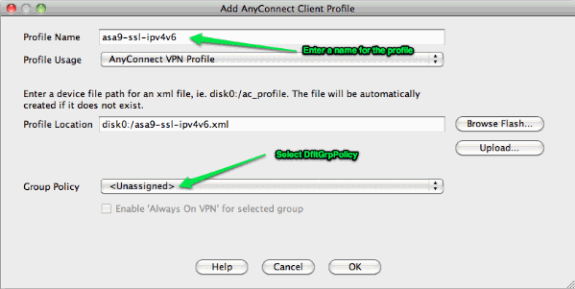
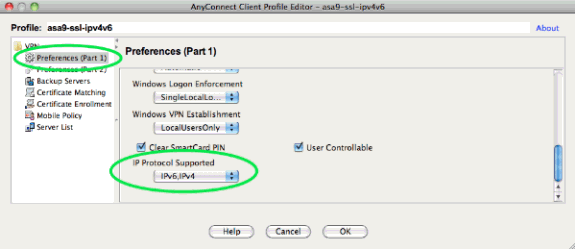
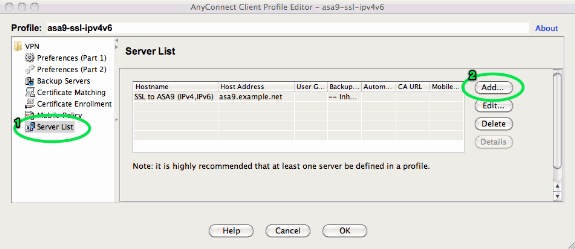
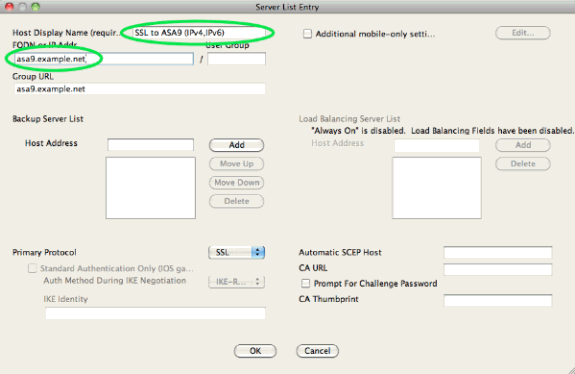
The resulting XML profile (with most of the default part omitted for brevity):
<?xml version="1.0" encoding="UTF-8"?> <AnyConnectProfile xmlns="http://schemas.xmlsoap.org/encoding/" xmlns:xsi="http://www.w3.org/2001/XMLSchema-instance" xsi:schemaLocation="http://schemas.xmlsoap.org/encoding/ AnyConnectProfile.xsd"> <ClientInitialization> ... <IPProtocolSupport>IPv6,IPv4</IPProtocolSupport> ... </ClientInitialization> <ServerList> <HostEntry> <HostName>SSL to ASA9 (IPv4,IPv6)</HostName> <HostAddress>asa9.example.net</HostAddress> </HostEntry> </ServerList> </AnyConnectProfile>
In the above profile a HostName is also defined (which can be anything, it does not need to match the ASA's actual hostname), and a HostAddress (which is typically the ASA's FQDN).
Note: The HostAddress field can be left empty, but tthe HostName field must contain the ASA's FQDN.
Note: Unless the profile is pre-deployed, the first connection requires the user to type in the FQDN of the ASA. This initial connection will prefer IPv4. After successful connection, the profile will be downloaded. From there, the profile settings will be applied.
Verify
In order to verify whether a client is connected over IPv4 or IPv6, check either the client GUI or the VPN session DB on the ASA:
-
On the client, open the Advanced window, go to the Statistics tab and verify the IP address of the "Server".
This first user is connecting from a Windows XP system without IPv6 support:
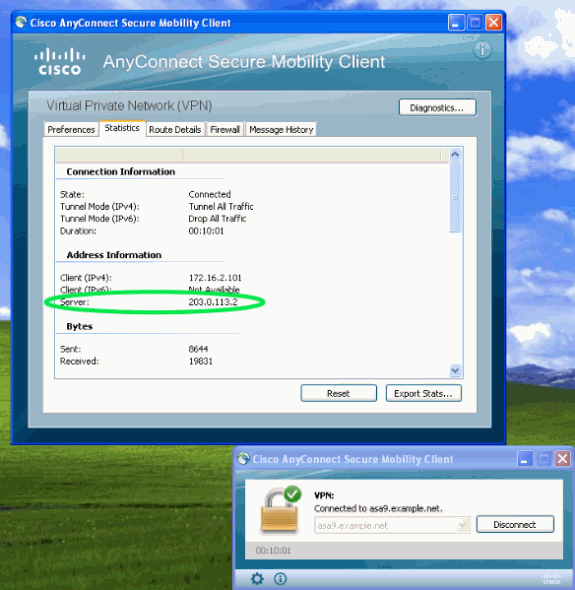
This second user connects from a Windows 7 host with IPv6 connectivity to the ASA:
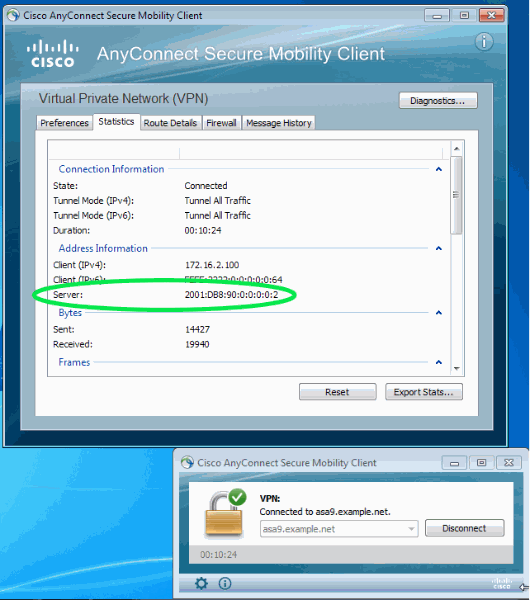
-
On the ASA, from the CLI check the "Public IP" in the "show vpn-sessiondb anyconnect" output. In this example you can see the same two connections as above: one from XP over IPv4 and one from Windows 7 over IPv6:
asa9# show vpn-sessiondb anyconnect Session Type: AnyConnect Username : Nanashi no Gombei Index : 45 Assigned IP : 172.16.2.101 Public IP : 192.0.2.95 Protocol : AnyConnect-Parent SSL-Tunnel DTLS-Tunnel License : AnyConnect Premium Encryption : AnyConnect-Parent: (1)none SSL-Tunnel: (1)RC4 DTLS-Tunnel: (1)AES128 Hashing : AnyConnect-Parent: (1)none SSL-Tunnel: (1)SHA1 DTLS-Tunnel: (1)SHA1 Bytes Tx : 13138 Bytes Rx : 22656 Group Policy : DfltGrpPolicy Tunnel Group : DefaultWEBVPNGroup Login Time : 11:14:29 UTC Fri Oct 12 2012 Duration : 1h:45m:14s Inactivity : 0h:00m:00s NAC Result : Unknown VLAN Mapping : N/A VLAN : none Username : Uno Who Index : 48 Assigned IP : 172.16.2.100 Public IP : 2001:db8:91::7 Assigned IPv6: fcfe:2222::64 Protocol : AnyConnect-Parent SSL-Tunnel DTLS-Tunnel License : AnyConnect Premium Encryption : AnyConnect-Parent: (1)none SSL-Tunnel: (1)RC4 DTLS-Tunnel: (1)AES128 Hashing : AnyConnect-Parent: (1)none SSL-Tunnel: (1)SHA1 DTLS-Tunnel: (1)SHA1 Bytes Tx : 11068 Bytes Rx : 10355 Group Policy : DfltGrpPolicy Tunnel Group : DefaultWEBVPNGroup Login Time : 12:55:45 UTC Fri Oct 12 2012 Duration : 0h:03m:58s Inactivity : 0h:00m:00s NAC Result : Unknown VLAN Mapping : N/A VLAN : none
Related Information
Revision History
| Revision | Publish Date | Comments |
|---|---|---|
1.0 |
18-Jan-2013 |
Initial Release |
Contact Cisco
- Open a Support Case

- (Requires a Cisco Service Contract)


 Feedback
Feedback